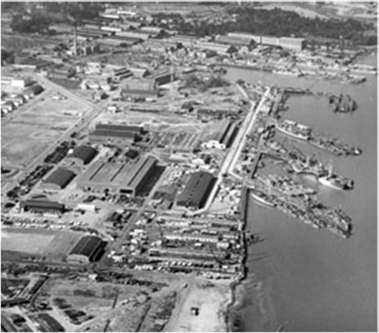-
Find information about traveling to Charleston.
Travel to Charleston
-
Visiting Charleston? Find information when visiting campus.
Check-In
-
Find information on student resources, campus services, campus policies, and more at the Charleston campus.
Campus Life
-
Find phone numbers for the Charleston campus including general information, facilities, and agency contacts.
Phone Directory
The Federal Law Enforcement Training Center (FLETC), located in Charleston, South Carolina, is situated on the site of the former Charleston Naval Base. It is one of three FLETC residential training sites in the United States. The Charleston facility officially entered the FLETC inventory through legislation in Fiscal Year (FY) 2003, when the FLETC was transferred to the Department of Homeland Security. Current operations began on October 1, 2004.
In December 2004, the U.S. Coast Guard officially consolidated its Boarding Officer and Boarding Team Member Schools by commissioning the Maritime Law Enforcement Academy at the FLETC-Charleston. The U.S. Courts, Federal Probation and Pretrial Academy was established at the FLETC-Charleston in January 2005. In FY 2007, Customs and Border Protection and the Immigration and Customs Enforcement stood up satellite academies. The Naval Criminal Investigative Service also began training at the facility in FY 2007, and the Food and Drug Administration came to Charleston in FY 2012. In January 2016, the U.S. Citizenship and Immigration Services established its academy training center, and in FY 2019, the Transportation Security Administration became the latest training partner to establish an academy at the Charleston site.
The Charleston facility consists of a total of over 200 acres. Additionally, FLETC-Charleston has a use agreement with the U.S. Air Force for outdoor firearms training ranges located on the Joint Base Charleston-Weapons Station in Goose Creek, South Carolina.
The Complex is located on the Cooper River with easy access to the Charleston Harbor and multiple port terminals nearby, which makes it an ideal location for maritime training. Among the site’s maritime training facilities are a 494-foot break bulk freighter that serves as an in-water training platform, an aquatic center, 13 stand-alone boat boarding platforms, and a covered, open-sided structure that holds six trailered vessels, a self-propelled semi-submersible and a yola fishing vessel. The main campus also includes a classroom complex, physical training facilities, non-lethal training areas, an indoor firing range, and a Student Center which includes an express store, barber shop, movie theater, Internet café, and a deli/coffee shop.
Continued construction and renovation of buildings, dormitories, and platforms to accommodate a wide array of Partner Organization training requirements remain a high priority.
The city of Charleston, South Carolina, is steeped in history, having been established nearly 350 years ago in 1670. While the land the Federal Law Enforcement Training Centers (FLETC)-Charleston facility currently resides does not have as deep of historical roots as the city itself, it still has seen its share of history as a long-standing former naval base.
Established in 1901 and deactivated in 1995, the Charleston Naval Base, also known as the Naval Shipyard, was a navy shipbuilding and repair facility and served as headquarters for the U.S. Navy's Sixth District for most of its existence.
World War II saw the Charleston Naval Base reach its highest employment and shipbuilding rate. By 1944, base employment had reached an unprecedented 26,000. Additionally, during the war more than 200 vessels of all sorts were built, with many more vessels being repaired. In the last months of the war, the Charleston facility began laying off its workforce; however, the outbreak of the Korean War in 1950 revived the facility once again.
During the Cold War, the base became a center for refitting the Navy's nuclear submarine fleet, and until the collapse of the Soviet Union remained instrumental in the Navy's nuclear submarine program. After 1990, the naval facility became less important. Despite efforts by the state's congressional delegation, the base was closed in 1995 as a result of the Base Realignment and Closures Act of 1993.

Aerial view of the Charleston Navy Base during WWII.
In 1996, the U.S. Border Patrol acquired a portion of the former naval base from the Charleston Naval Complex Redevelopment Authority for the purpose of a temporary training site. FLETC subsequently added the Charleston facility to its inventory through legislation in 2003 when the site was transferred to the Department of Homeland Security. Current operations began October 1, 2004.
The portion of the old naval base where the FLETC-Charleston is located is known as a federal enclave, which is a parcel of federal property within a state that is under the "Special Maritime and Territorial Jurisdiction of the United States." The training site consists of 202 acres in the more than 1,600 acres within the old naval base, with the remaining acreage leased or owned by other government entities and private sector businesses.
Co-located on the enclave are a number of other federal agencies: the U.S. Department of State, the National Oceanic and Atmospheric Administration, the U.S. Coast Guard Base Charleston, the SeaHawk Interagency Operations Center, and the U.S. Maritime Administration. Several administrative and operational law enforcement agencies, as well as commercial businesses, are also co-located within the Complex.
The FLETC-Charleston site with its rich and varied history, only adds to its reputation as a facility that gets better with time as it continues to contribute to the Homeland Security mission.

